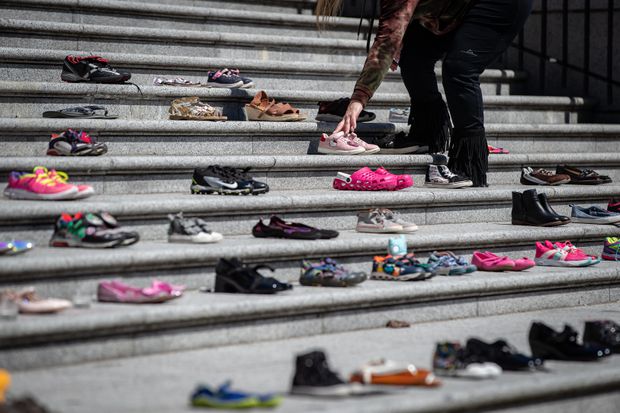KAMLOOPS (CANADA)
The Globe and Mail [Toronto, Canada]
May 30, 2021
By Mary Ellen Turpel-LaFond
Mary Ellen Turpel-Lafond (Aki-Kwe) is the director of the Residential School History and Dialogue Centre and a professor of law at the Peter A. Allard School of Law, at the University of British Columbia.
Many Canadians have expressed their horror, shock and sadness at the announcement that the unmarked buried remains of 215 children were discovered in preliminary radar findings last weekend at the site of the former Kamloops Indian Residential School in British Columbia. And we should be sad; it is horrific. But it is not shocking. In fact, it is the opposite – a too-common unearthing of the legacy, and enduring reality, of colonialism in Canada. To the degree it is shocking, it is evidence of how much learning there is still to do.
Kukpi7 Rosanne Casimir, the chief of Tk’emlups te Secwepemc First Nation, said it best: She called the discovery of the mass grave an “unthinkable loss.” But as she importantly made clear, it was also a known loss – that is, the deaths were undocumented, but the community “had knowledge” of them.
Unthinkable, undocumented, and yet known. This is the reality faced by Indigenous communities across this country. First Nations, Inuit and Métis communities, reflecting the ways in which knowledge is shared and passed on between generations, all have stories of the wrongs that were perpetrated through colonization.
These are stories of people disappearing, violence and physical harm, land and property being taken, and culture and language being outlawed. Some of these stories are shared outside of the communities. Many of them are not. They echo with pain and trauma that is often too much to share broadly.
In recent years, the Canadian public has gained some window into these unthinkable losses. Through the Truth and Reconciliation Commission (TRC), the National Inquiry into Missing and Murdered Indigenous Women and Girls (MMIWG) and other studies and investigations, there has been some documentation of these horrors, and with it, some important learning.
This sharing has not come without a cost, however: For survivors and their communities, helping others understand often has involved re-experiencing some forms of trauma. By choosing to educate Canadians, survivors had to make another tremendous sacrifice.

But while we now, importantly, have documented a great deal, many more wrongs remain unmarked. We need to understand that for all the wrongs that are now written about and taught to children in classrooms, they are the tip of the iceberg; underneath them lies countless more. Some of these have been lost to time, but many are remembered, as they were in Tk’emlups.
But beyond memory, discovery, learning and documentation – processes in which we all have a responsibility to participate – there is the other responsibility that lies with all of us, and our governments: to enact real change. Not merely symbolic and superficial change, and not change in the name of scoring political points.
The necessary change must attack the root cause of the injustice faced by Indigenous peoples: the state’s long-standing treatment of Indigenous peoples as subhuman, without basic human rights. As individuals, Indigenous peoples have faced racism, stereotyping, disproportionate harm and violence at the hands of the state, even as it closed off social and economic opportunities. As collectives, Indigenous peoples have endured the dismantling of their governmental and legal systems, the outlawing of aspects of their culture and society, and attacks on their family systems.
The legacy and continuation of this rights denial is at the heart of the challenges we must confront, which include vast numbers of children in care, overrepresentation in the criminal justice system, poverty, inadequate housing, diminished educational and economic outcomes, and high rates of suicide.
We know the solutions, because Indigenous peoples have spent decades bringing them forward. The Royal Commission on Aboriginal Peoples, the TRC and the MMIWG inquiry are among those that have repeated the call time and again: to uphold Indigenous rights, such as those in the United Nations Declaration on the Rights of Indigenous Peoples, and to change government legislation, policy and practices so these rights are recognized and implemented.
Only when Indigenous peoples have the opportunity, authority, accountability and support to care for their own communities and families – through the governments they have determined and according to their own laws and traditions – will the challenges that are with us be addressed.
So yes: Let us mourn these lives tragically lost. Let us name the children, to ensure we know who they are and so we can return them to whom they belong. But to honour their lives and countless others, let us act. Let us break the patterns of fighting in courts and legislatures over whether Indigenous peoples have rights, and get on implementing them in tangible ways. Only by doing this are we showing that, indeed, we are breaking from the past.
